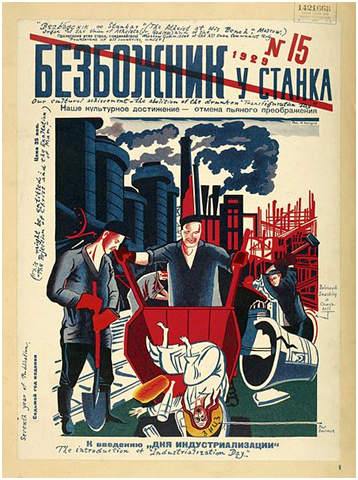The Persecution of the Church in the Soviet Union: A Story That Needs to Be Told
John A. Das
There is a topic that people seldom mention today. It involves events that took place less than one hundred years ago and dealt a devastating blow to the Catholic Church—the brutal killing of millions of its faithful.
This seldom-mentioned topic is the persecution of Christians under the Marxist-Leninist doctrine of militant State atheism in the former Eastern Bloc countries. Fortunately, the darkness surrounding this subject is being lifted by those like Geraldine Kelley, who recently translated the original entries for the Book of Remembrance: Biographies of Catholic Clergy and Laity Repressed in the Soviet Union (USSR) from 1918 to 1953, a voluminous collection that details the lives of Roman and Eastern Rite Catholics who suffered and died for our precious Faith. In addition, a new documentary film titled Martyred in the USSR: Militant Atheism in the former Soviet Union will soon be released which will bring to light the dark history of this great attack on religion.
This is a story that needs to be told. The attack against religion in countries of the Warsaw Pact was inspired by the ideology of Marxism-Leninism, which upheld “militant atheism,” a doctrine advocating the abolition of religion and the propagation of atheism. Government officials worked tirelessly to sanitize the public sphere of any trace of religion.
The way militant atheism worked in practice was very methodical. In 1918, the Union of Soviet Socialist Republics, under Lenin, implemented a policy of separation of Church and State, which meant that all Church property (including monasteries, charitable and social works and even liturgical items) was nationalized without compensation. Priests, monks and nuns (especially those who opposed these policies) were taken away to the Gulag and oftentimes executed. By 1926, there were no more Roman Catholic bishops left in the USSR. The Catholic laity also met the same fate, whether by firing squad, being sent to “corrective labor” camps, or to psychiatric hospitals for “treatment,” most never to be seen again. Several thousand churches of all Christian denominations were either closed, liquidated or forcibly converted into “Museums of Atheism.” By 1941, of the nearly 1,200 Catholic churches that had existed in 1917, only two were still active. In addition, parochial schools were closed and the teaching of religion to minors was outlawed.

The ruins of the Cathedral of the Immaculate Conception of the Holy Virgin Mary in Moscow after it was forcibly closed in 1938 under the Soviet doctrine of gosateizm.
Photo Credit: Artur Kamalin. Photo circa 1980. CC BY-SA 3.0
In elementary schools, children were taught to denounce parents who held onto their Faith. After 1964, university students were required to take a course titled “Fundamentals of Scientific Atheism,” although few students were genuinely interested in it. Throughout the existence of the Soviet Union, several antireligious campaigns were carried out in order to eliminate religion from the public square. One of the worst of these was the antireligious campaign carried out under Nikita Khrushchev, who revoked the parental right to instruct children in the Faith.
Eastern Rite Catholics, such as the Ruthenian Catholic Church and Ukrainian Greek Catholic Church, faced increased pressure by Soviet authorities to separate themselves from the Holy See. In the encyclical Orientales omnes Ecclesias, Pope Pius XII praised them for bearing the persecution inflicted on them by the atheistic communist government.
A blasphemous cover of the Soviet magazine Bezbozhnik (Atheist)
depicting Our Lord being dumped by industrial workers.
depicting Our Lord being dumped by industrial workers.
An organization called the League of Militant Atheists, which boasted a membership of 5.6 million persons in 1932, sent out atheist missionaries to convert Soviet citizens located in rural parts of the country. Atheistic literature numbering a total of 800 million pages was distributed throughout the USSR. To those who did not warmly receive its message, the League of Militant Atheists resorted to implementing a bloody approach on these innocent believers, by imprisoning clergy and laity or placing them before firing squads. Sister Anna Abrikosova, foundress of the Religious Sisters of the Third Order of St. Dominic, was arrested by the OGPU (Obyedinyonnoye Gosudarstvennoye Politicheskoye Upravleniye, commonly referred to as the Joint State Political Directorate, however, the predecessor of the NKVD and the KGB), spent several years in prison, and toiled in a labor camp for eight years before perishing on July 23, 1936. She is now recognized as a Servant of God by the Catholic Church.
The upcoming historical documentary, Martyred in the USSR: Militant Atheism in the former Soviet Union, is currently being made to tell the stories of those who were persecuted by militant atheists for clinging to their faith. Unfortunately the battle is not over as militant atheism still persists today in the West. This can be seen in the actions of some leaders in the New Atheism movement that call on their followers to “mock and ridicule” people of faith. The media often portray Catholics as enemies of “progress,” calling them “backwards.” Such tactics are reminiscent of the antireligious actions that were commonplace in the Union of Soviet Socialist Republics. Only by learning from history does one prevent it from being repeated. That is why it is so important to teach the public about what happened to people of faith in the Eastern Bloc under the Marxist-Leninist policy of militant State atheism. Those who wish to help make the stories of these Christian martyrs known are encouraged to visit the web site of the soon-to-be-released film at martyredintheussr.com.

